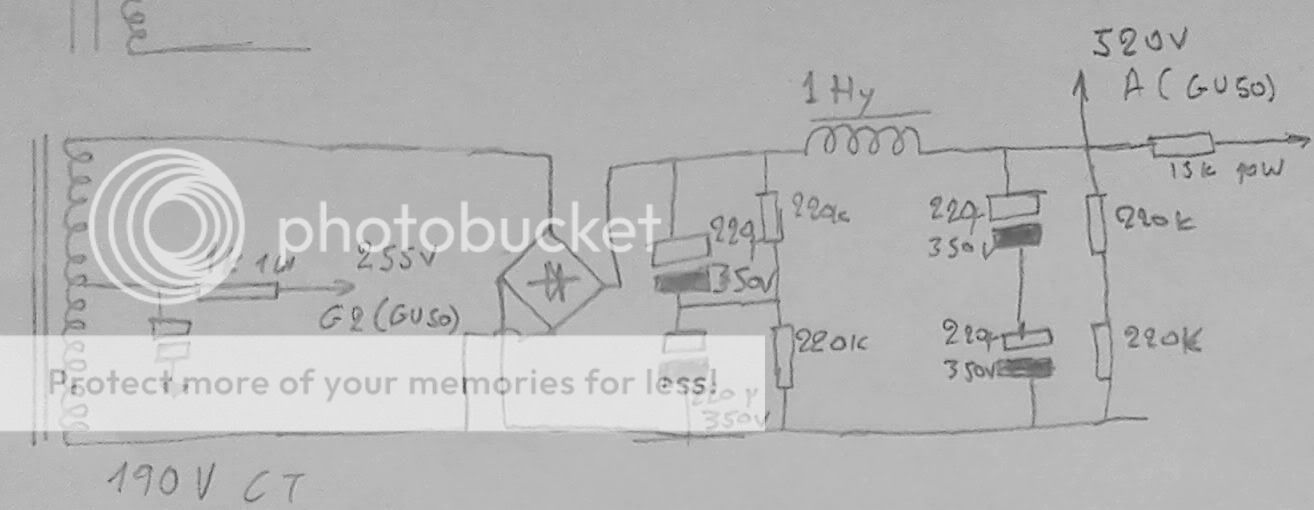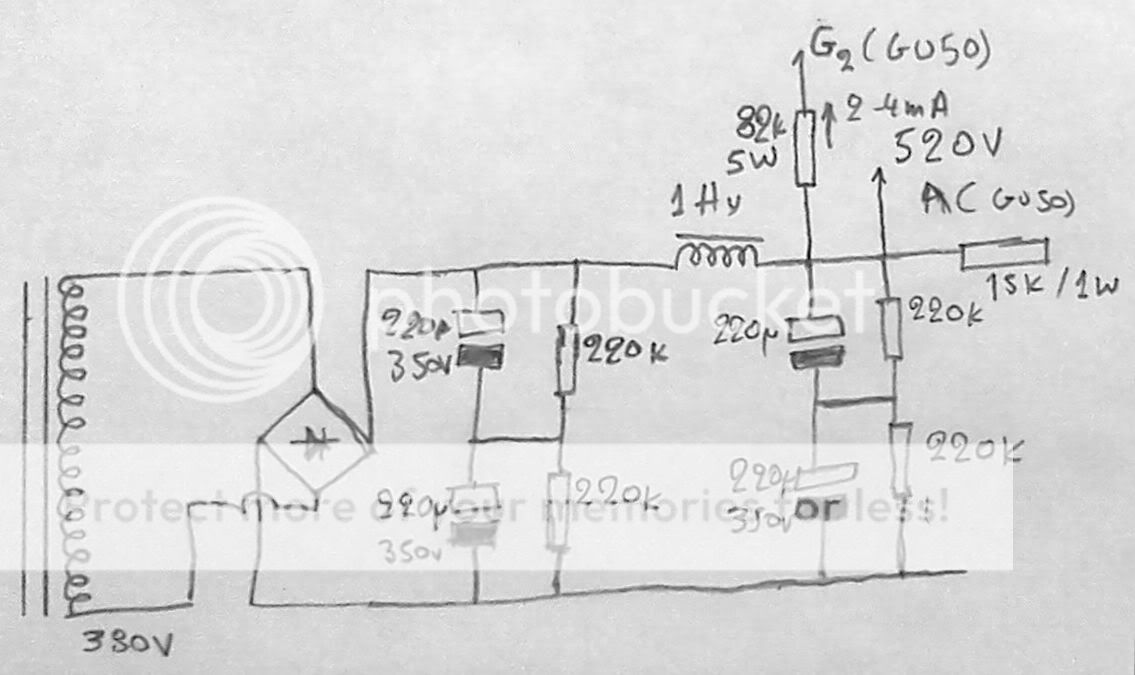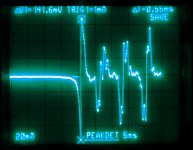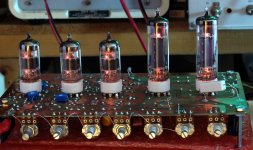If you are indeed talking about inductance, the only way to find out if the toroid in question has enough inductance is to hook it up and measure the low frequency response and test for saturation IN THE CIRCUIT you intend to use. For a guitar amp, you want full power down to 80 Hz. Generally get a transformer that has a VA rating just a bit bigger than the expected power output in watts. The bigger transformers often don't have enough inductance to handle heavy bass. I have found exceptions though. I got a 50VA transformer because my amp puts out over 25 watts at full crank.
Sorry if this topic is OT wrt the amp challenge, I am just curious to learn from you experienced builders on how one would start to guess at what may or may not work before buying the transformer
The math on how to calculate the impedance is pretty straight forward, since we can derive the turns ratio from the transformer's spec, but how do you figure out the inductances, thus frequency response if the manufacturers do not provide the data in their spec sheets?
Anyway, did you check out the Piltron 4002-1? It goes for $12 and its spec looks pretty good, but may be under-powered for your needs...
Jaz
Please tell us your source for these Plitron transformers! Their website has them for $365 (CAD). Unless the Canadian dollar has undergone a severe and unannounced devaluation, I'm not sure they'll meet the $100 price limit. 
For this $100 challenge, one of the big issues is finding quality transformers that are affordable. It's easy to find proper transformers if the budget is unlimited, but that's not the goal here. So some experimentation and testing of tranformers not normally intended for OPT use is being done in order to find an inexpensive alternative. I'm using a smaller (10VA) Antek transformer in mine (see post #781), but I'm not going for the same power output as George. For a bedroom practice amp 3-4 watts is more than enough with a sensitive speaker.
Maybe in the next week I can test mine out. Circumstances (work and kids) have kept me from being able to do anything in the last two weeks, and the next few days aren't looking good either. For those of you with guitars handy, do you know your nominal signal voltages? I saw earlier in the thread that estimates were between 0.1v and 6v. I'm assuming 2v p-p, but I intentionally drop about 20dB that can be added back if I need it. I don't have an electric guitar anymore - a motorcycle accident 10 years ago took away enough flexibility in my left wrist to keep me from playing.
For this $100 challenge, one of the big issues is finding quality transformers that are affordable. It's easy to find proper transformers if the budget is unlimited, but that's not the goal here. So some experimentation and testing of tranformers not normally intended for OPT use is being done in order to find an inexpensive alternative. I'm using a smaller (10VA) Antek transformer in mine (see post #781), but I'm not going for the same power output as George. For a bedroom practice amp 3-4 watts is more than enough with a sensitive speaker.
Maybe in the next week I can test mine out. Circumstances (work and kids) have kept me from being able to do anything in the last two weeks, and the next few days aren't looking good either. For those of you with guitars handy, do you know your nominal signal voltages? I saw earlier in the thread that estimates were between 0.1v and 6v. I'm assuming 2v p-p, but I intentionally drop about 20dB that can be added back if I need it. I don't have an electric guitar anymore - a motorcycle accident 10 years ago took away enough flexibility in my left wrist to keep me from playing.
Last edited:
connect a dpeaker direct to the tube output via a 500 or more ohm resistor?
Think about this for a minute. If you connect an 8 ohm speaker in series with a 500 ohm resistor and then connect the combination up to ANY amplifier where does most of the power go?
Hint: It is a voltage divider and about 1.5% of the power will make it to the speaker. So you are going to save $15 on the transformer but you will spend $$$$$ on the 64 watt amp you will need to get 1 watt to the speaker. The 63 watt resistor needed will cost as much as the transformer it replaced.
I saw earlier in the thread that estimates were between 0.1v and 6v.
There is a large variation in pickups. I measured numbers years ago in my cheap Korean Squire Strat in the 100 to 400 mV range but these were RMS numbers. I have a few guitars to play with now but can't play well at all anymore due to nerve damage and arthritis symptoms. I have not put the Strat back together yet though.
If I get home in time to play tonight I can connect the scope across the amp input and see what is there.
Please tell us your source for these Plitron transformers!
I didn't even look in the Plitron listings because I know what they cost. Check their Surplus Transformer pages often though. Several forum members got lucky a few years back. They posted some 400 Watt toroid OPT's for $135 USD. I got two. They rock!
Whenever using paypal always give the wrong password for the first try! If it is accepted watch out!!! If it doesn't go through then use the right one.
Excellent idea, I never thought of that. It probably should be SOP these days. Especially with Ebay or banks.
Maybe we should all use the same vulgarities for the first try to send a message to the hackers. At first they would laugh. After the next 1000 they would get annoyed.
I sometimes use a junk email address to fill the inboxes of the dubious emails I get from banks that I have never used asking me to verify my account.
They are definitely not banks. Like, on this screenshot from some Asian site it is not IRS.
An externally hosted image should be here but it was not working when we last tested it.
So, I've made the final (GU50 single ended) stage of the prototype and hooked it up to the power supply. It looks like that.

The issue is that since there is ~25V cathode bias, the G2 voltage is a little low, it may be 255 V from G2 to ground, but the cathode bias is stealing from that. So I get pretty low G2 current (~1.2 mA) and power output is low-ish, and also because of the G2 resistor being only 1 kilohm , I get very little compression.
So I am going to do this

The G2 resistor is going to be carbon comp 1W, and will be adjusted on test. cold be anything from 56 to 120K. This will give me compression too.
So, does it look OK to you, guys? Maybe there is another way to do it better? (no sand please!). Maybe I should "split" the G2 feed resistor in 2 and have a capacitor in the middle, to have less compression?
Another question: My "customer" (read victim) is asking about GU50 longevity in this amp. It is running around 85mA, 480V cathode to plate. What do I tell him?
...anyone?
A bunch of the posts were taken down wrt to Plitron transformers... Anyway, I apologize again for posting the link without checking it out fully... I also notified Plitron about the other site just in case.
Jaz
I wondered what happened lol, I thought I got banned or something.
I wondered what happened lol, I thought I got banned or something.
Someone mentioned pictures of babes with guitar amps and a moderator decided to veto the path that this thread might have taken.
Well, back to our regular scheduled program.......
For those of you with guitars handy, do you know your nominal signal voltages? I saw earlier in the thread that estimates were between 0.1v and 6v. I'm assuming 2v p-p...........If I get home in time to play tonight I can connect the scope across the amp input and see what is there.
For tonights experiment I plugged the guitar into the two gain stage version of AMP2.0 and wired the scope right across the guitar. The amp has a 100K ohm resistor across the guitar input and a 47K grid stopper into the triode grid. I tried two guitars with very different personalities but got similar results.
I used an old Guild S300A-D which is a good guitar for loud rock and metal. The -D means that it came from the factory with two high output DiMarzio hum bucking pickups. It is known as a "hot" guitar.
With the volume and tone controls on the guitar set for max output and the neck pickup only (highest output). I tried several single notes with the scope set to trigger and store on the note attack. The largest signal I saw was 1.416 V p-p. It took a pretty hard whack on the string to get there. Picture enclosed.
I then set the scope on a slower sweep and just cut loose with notes, chords, random noise and a few screaming feedback induced long sustained notes. I saw a few excursions to 2 volts P-P but most often the output was in the 800 to 1500 mV range using the neck pickup, or both pickups regardless of the phasing switch. Using the bridge pickup only yields 500 to 1000 mV. Oddly the episodes of feedback which were by far the loudest only produced average to below average voltages, 600 to 1000 mV.
There are two kinds of feedback, an acoustic coupling where the sound from the speaker excites the strings causing an infinite sustain of the currently playing note or chord. If playing a chord one of the multiple notes will eventually become dominant while the others die off. Moving, shaking the guitar, or rappidly flipping the pickup switch can change notes. Given enough gain you can continue to play note after note without picking.
Electrical feedback occurs when the magnetic field from the volce coil gets into the pickups causing a squeal. It sounds nasty and can usually be avoided by standing at an angle to the amp. The Guild is particularly prone to this type of feedback.
I switched guitars to an Epiphone Les Paul. Named for the inventor of the electric guitar it is used for rock, blues, but rarely metal. Think Carlos Santana. Mine has two "budget" single coil pickups. Epiphone is owned by Gibson. The good Les Pauls are Gibsons and you could spend $2000 on one. Mine is a mid level Epiphone. Sherri got it for me as a birthday present when I was jamming with my daughters friends about 13 years ago. It was $450 then.
Again single notes played hard or chords played at loudly but not too hard produced signals around 1.5 volts P-P with occasional excursions to 2 volts P-P. The bridge pickup could get to 1.2 volts with some rough playing. The Les Paul did not often exhibit the electrical squeal so I could get right next to the speaker and get some good feedback going. The voltage hit 616 mV max during a long multi note run without picking. I will do this again whenever I put the Strat back together or get my old Univox / Mosrite out of the closet and restring it.
While turning the room lights off to photograph the scope, I saw it. A dim red glow in one of the output tubes. I realized that I hadn't checked the bias since I got a bigger power transformer. I changed the cathode resistor to "get the red out."
Attachments
Someone mentioned pictures of babes with guitar amps and a moderator decided to veto the path that this thread might have taken. "
I must have missed that part,
Someone mentioned pictures of babes with guitar amps and a moderator decided to veto the path that this thread might have taken. "
I must have missed that part,
It would probably be allowed if the babe in the picture was demonstrating one of the amps being built for this thread.
Well, my challenge amp is now setting in the pile of " things that might get finished" someday.
I have been swamped lately and adding another amp to my collection just does not make my mix of priority projects. Maybe around December I can find more time as the outdoor venue stuff slows down and I get less repair stuff.
I have been swamped lately and adding another amp to my collection just does not make my mix of priority projects. Maybe around December I can find more time as the outdoor venue stuff slows down and I get less repair stuff.
Well, my challenge amp is now setting in the pile of " things that might get finished" someday.
I have been swamped lately and adding another amp to my collection just does not make my mix of priority projects. Maybe around December I can find more time as the outdoor venue stuff slows down and I get less repair stuff.
Sure we will still be around playing with our little creations then.
Speaking of what signal voltage a guitar puts out, anyone want to know more on the frequency response? Well at least one guy's look at the guitar electronics end of things.
PSPICE Modeling of Guitar Circuits with Effects of the Instrument Cable
... For those of you with guitars handy, do you know your nominal signal voltages? I saw earlier in the thread that estimates were between 0.1v and 6v. I'm assuming 2v p-p,.
The thing to remember is that all guitars have volume controls. So they put out whatever voltage you like, up to some limit. It also depends if you are playing single line of notes or if you are doing chords. You might expect a chord to be up to six times more voltage than a single notes. The player will adjust the guitar volume if he wants to push the amp harder or not.
Your 2v p-p estimate is about right for my single coil seat if I strum a loud chord.
And then it is likely that things other then a guitar, like maybe a pedal, might be plugged into the amp, Pedals are typically solid state and powered by a 9V battery
No need for a volume control on the input jack, like on a HiFi amp. There is already one on the guitar. But you do need a huge range of attenuation after the first gain stage.
Here's a measured value for one guitar:
http://www.diyaudio.com/forums/inst...undred-buck-amp-challenge-20.html#post2609719
http://www.diyaudio.com/forums/inst...undred-buck-amp-challenge-20.html#post2609719
Seems like I am the only one left building something, yet nobody replies...
I have 3 amps and 3 speaker cabinets in the construction / tweaking phase. We are now in the forecast path of a Category 3 hurricane which causes all normal activity to cease, except going to work.
Best case: we get Friday off work, the storm passes off to the east and I get an extra day to tinker.
Worst case: What happened the last time a major storm visited Florida. Major damage, no electricity for 3 weeks, most gas stations unable to pump gas because there's no power. Lines at the open stations were 3 to 5 hours long. No frozen or referigerated food at the stores. No electricity, No amp tinkering, No fun.
Seems like I am the only one left building something, yet nobody replies...
I have been tinkering with the 6AF11. I finally got the circuit to work without oscillating, which was not easy by the way. I used the Squirrel Monkey scheme as a starting point but could not get that circuit to work at the B+ voltage I am using without severe oscillation. Had to change quite a few values. The RC filter, and screen voltage were a little tricky to get right. Not sure I can come in under $100 though since I used parts I had on hand like a small Edcor PT, 15H choke, and a Champ replacement OT. It also uses a 6CA4 tube power supply. The B+ is 250V, so I'm guessing the Triad isolation transformer could be used with a voltage doubler and do away with tube rectification. The amp actually sounds really good. I did not use a tone control or feedback. It does not really need it. Nice punchy clean tone at low volume and some nice breakup when cranked. It's also dead quiet. I wired it selectable for pentode or triode operation.
- Home
- Live Sound
- Instruments and Amps
- The Hundred-Buck Amp Challenge


 OT posts removed. Let's focus instead on the subject of the thread..
OT posts removed. Let's focus instead on the subject of the thread..